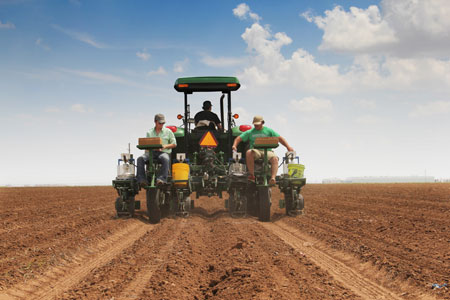By Sinclaire Dobelbower

Hunter Parrott, Joel Arce and David Brockman work hard to get the 2015 test plots planted. Photo By Sinclaire Dobelbower
Innovation. Adaptation. Ingenuity. These are all words that describe the cotton industry in the High Plains. One of the main reasons the industry has been so successful is due to the increasing number of cotton varieties available today.
Dr. Jane Dever, Associate Professor of Soil and Crop Sciences and Cotton Breeder at Texas A&M AgriLife Research in Lubbock, Texas, works to improve cotton varieties for the area through specifically funded research projects and training graduate students. Dever believes we have seen changes to the varieties grown in the area in response to identified needs or changes to production systems.
“One of my first memories in plant breeding is when I started at AgriLife as a student worker in 1983 and PCCA responded to a need for better fiber strength,” said Dever. “They did an analysis, indeed found that we were getting paid less for our cotton, and helped to start the Plains Cotton Improvement Program that helps fund our breeding program. It was in direct response to a need that came from the market side to improve quality and yield,” said Dever.
Similar needs and situations also have been determining factors in the development of cotton varieties. Dr. Dever has worked first-hand on several projects to improve the Texas High Plains cotton crop and has seen multiple innovations to the plant’s potential.
“We’ve seen an incredible improvement in fiber quality, along with varieties that have longer maturity cycles, made possible by boll weevil eradication and Bt cotton, plus changes in irrigation and management practices that allow us to introduce varieties that have better yield potential,” said Dever.
An important question for producers to consider when selecting a cotton variety to plant is what kind of situation and production system they have. Dr. Dever said when selecting a variety to plant, “There aren’t necessarily wrong varieties or right varieties, but there are appropriate ones for your situation, and if you plant a variety that is not appropriate, it is a decision you have to live with all year long.” To ensure that a variety will be appropriate, Dr. Dever suggests trying a new variety on a small scale of acreage that stays inside the realm of a grower’s production system. Another factor behind selecting varieties is protecting the producers while pleasing the mills.
“There’s not always a huge financial incentive to grow high fiber quality cotton, but there is a huge incentive to grow cotton that fits in your production system that yields consistently,” said Dever. “The value of fiber quality depends on supply and demand of that market, so it tends to be a more market driven objective, where as gearing varieties to produce higher quality yield is more production driven.”
David Canale with TELMARK, a subsidiary of PCCA that was founded to provide electronic cotton marketing services to independent gins and their customers, said the price and demand for cotton is driven by the world economy and that is key to what producers decide to produce.
“Fifteen to twenty years ago we were growing one-inch style cotton, but there is no market for it anymore,” said Canale. “Thanks to the development of new varieties, we now can produce more longer, stronger cotton on less acreage to meet new demands.”
Dr. Dever’s favorite word to describe the nature of plant breeding is resilience, and that word definitely describes the nature of the industry right now. New demands are certainly on the horizon, and PCCA members and producers can look forward to a continuation of new seed varieties to rise up and meet these demands. Expected developments include improved varieties of nematode resistance, drought and stress tolerance, new options in biotechnology traits and technology for herbicide modes of action.
“Cottonseed companies in partnership with public breeding programs are going to be looking at native traits that are quantitative for drought tolerance and stress resistance for more resilience,” said Dever. “Resilience can’t be defined by a molecular marker, but by more genetic variation to identify what is important to our environment and to develope a better variety package with which to deliver valuable traits important to our growers.”
The only thing that is constant in life is change, and the same can be said for the cotton industry. With change comes new and improved methods of production, increases in quality and yield, and reassurance of selling the best cotton possible for the ideal price. The future of the industry will do what it has always done, which is adapt, overcome and improve.
The Plains Cotton Improvement Program
The Plains Cotton Improvement Program (PCIP) was created in 1982 by Texas High Plains cotton producers and leaders of the region’s warehouse industry.
“The goal of the PCIP is to actively work to improve the fiber and yield characteristics of the High Plains crop and to change the textile industry’s view of High Plains cotton,” said Mary Jane Buerkle, Director of Communications and Public Affairs for Plains Cotton Growers, Inc., in Lubbock.
The program was kick-started through the efforts of the late Joel Hembree, former fiber technologist and statistician at Plains Cotton Cooperative Association, and Rex McKinney, former manager of Lubbock-based Farmers Co-op Compress. They strived to meet a need to improve the quality of the cotton crops in the High Plains, and they found their answer through the establishment of the Plains Cotton Improvement Program that involves cotton geneticists, industry advising committees, and producers.
Plains Cotton Growers states that thanks to their investment in the PCIP, High Plains cotton growers are working together to create benefits many may not even realize they are receiving and to dispel any lingering myths that exist about the value and quality of the cotton produced in the High Plains of Texas.
“Growers fund the PCIP through a voluntary 10-cent per bale assessment collected by High Plains cotton warehouses. Growers also serve on the Plains Cotton Improvement Committee where they review research projects and help determine where funds are allocated relative to current industry needs,” said Buerkle.
By investing in the development of better cotton varieties for the future, the PCIP has raised producer awareness of the importance of the overall quality of the cotton they produce. Buerkle said that the future offers several promising benefits for producers.
“The PCIP has evolved greatly over the past three decades, and producers can look forward to continued innovation in cotton research, from seed breeding all the way through to the fabric and finished product,” said Buerkle.
Producers also are able to see the potential that the PCIP has to offer through providing enhanced research technology in order to improve fiber and yield quality.
Buerkle said that “Through the PCIP, producers will continue to realize significant benefits through partnerships with outstanding and highly respected cotton research scientists to make High Plains cotton even better and more marketable.”


